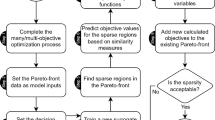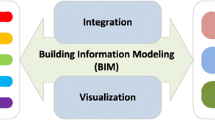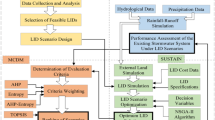Abstract
Rapid urbanization has many negative effects on environment such as deterioration of water quality contributed by pollution. In terms of stormwater management, even with the introduction of Manual Saliran Mesra Alam (MSMA) in 2000 (Urban Stormwater Management Manual for Malaysia), numerous new technologies have yet to be examined in detail, especially the relationship between water quantity and quality. Implementation is based on the restoration and optimization of the ecosystem. In this study, it has been reviewed and introduced the MSMA software in regard to water quality and discharge analysis for the future study. MSMA SME Design Aid and Database System knowledge base consists of a compilation of information and data relevant to stormwater treatment including algorithm for components, available design standard, technical guidelines, components design, supplier contact information, and images of each components and drawings. MSMA SME Design Aid and Database System framework consists of four main modules: user requirement input, analysis and design phase, prototype phase and user testing. There are 28 main components which have important role for visualization of any given catchment such as rainfall data, green roof, bioretention, constructed wetland, porous pavement, rainwater harvesting system, grey water reuse system and checking tools items. Currently, the 4 key components, such as bioretention system, water quality volume, lined drain design and bridge afflux estimator, have been developed in this study. MSMA SME Design Aid and Database System is able to assist engineers and developers in terms of management and improvement of water quantity and quality entering urban rivers from urban regions. This system is also helpful when an expert-level judgment is needed repetitively for a large amount of cases, like in the planning of stormwater BMPs systems for an entire city catchment.
Access provided by Autonomous University of Puebla. Download conference paper PDF
Similar content being viewed by others
Keywords
1 Introduction
One of the main concerns in Malaysia is urbanization which is fast and progressive. Rapid urbanization has many negative effects on environment such as deterioration of water quality contributed by pollution. One of the common negative impacts of urbanization is the congestion of the drainage system which leads to produce unmanaged freshwater and consequently flash flood. This circulation has caused trouble for water quality and related issues whether in urban or rural area. Generally, in the past, urban drainage systems have been built to narrow the riverbeds by the inclusion of concrete and other man-made materials. These types of drainage systems in urban area and the waterways were influenced by the solids in stormwater runoffs [1]. Moreover, the inclusion of litter, debris and sediments in drainage system will lead to the enhancement of the flood and decreasing quality of the water. These days, urban rivers have mostly been changed into artificial channels, and they collect both freshwaters and urban sewage from urban locations.
Pollution loading usually results in poor water quality. Consequently, the downstream areas obtain more effects derived from contaminated materials inside freshwaters in channel flow. In Malaysia, pollution of freshwaters in open channels is considered as one of the important topics for review and study in the future. It is clear that bacteriological or chemical quality of urban streams may cause a severe risk to public health. The result is that many urban watercourses have not had any amenity value to support the range of an ecosystem at least. Also, the quality of water in open channel flows does not meet the water quality objectives that have been offered by the Department of Irrigation and Drainage (DID), Malaysia. To perform a research on management of freshwaters, DID and related organizations such as Universiti Tenaga Nasional Malaysia have made an agreement to design a toolbox, namely MSMA Integrated Stormwater Management Eco Hydrology Design Aid and Database System (MSMA SME Design Aid and Database System). The MSMA SME Design Aid and Database System knowledge base consists of a compilation of information and data relevant to stormwater treatment. The MSMA SME Design Aid and Database System algorithm includes MSMA SME Design Aid and Database System components, available design standard, technical guidelines for MSMA SME Design Aid and Database System, components design, supplier contact information and images of each component and drawing.
MSMA SME Design Aid and Database System categorizes as one of the expert systems. Expert system is an interactive computer software/paradigm incorporating judgment, experience, rules of thumb, intuition and other expertise to provide knowledgeable advice about a variety of tasks to non-specialists [2]. Expert systems can cooperate as experts to make higher level decisions based on varying performance levels [3]. They can be described as new software technology that allows the formalization and representation of knowledge as well as experts. The objectives of this study are to assist in the solution development of MSMA SME Design Aid and Database System components and integrated stormwater management based on expert data and user input and to provide better understanding on the MSMA SME Design Aid and Database System components which cover all aspects including concepts, detailed design and performances. MSMA SME Design Aid and Database system is able to assist engineers and developers in terms of management and improvement of water quantity and quality entering urban rivers from urban regions.
2 Materials and Methods
2.1 Introduction of MSMA SME Design Aid and Database System Design Framework
The aim of the development of MSMA SME Design Aid and Database System is to assist in the solution development of MSMA SME Design Aid and Database System components and integrated stormwater management based on expert data and user input. Figure 1 shows the framework of four modules for MSMA SME Design Aid and Database System Design. Module 1 is related with feeding the input data and specification of catchment features. Next, module 2 is involved with the configuration of structural and non-structural component and attributed assessments. Module 3 includes with prototyping or providing first sampling of the integrated of model and database. Finally, module 4 is considered as evaluation of results or outputs with observed data which related with water quality and peak discharge.
2.2 Framework Module 1 (Database): Development Database for MSMA SME Design Aid and Database System
Indeed, the information is basically related to the MSMA SME Design Aid and Database System design standards available, MSMA SME Design Aid and Database System component factsheet and MSMA SME Design Aid and Database System design step and typical drawing. The input data is important prior to further analysis in the MSMA SME Design Aid and Database System as well as to forecast the model output and result analysis. The model input data includes appropriate rainfall data, infiltration rate and soil properties, inflow hydrograph and initial water quality data. The infiltration rate is the velocity or speed at which water enters into the soil. It is usually measured by the depth in millimetre of the water layer that can enter the soil in one hour. Inflow hydrograph is important parameter for measuring the rainfall capacity and flood routing. The catchment characteristics input includes catchment area, site analysis, and the selection of MSMA SME Design Aid and Database System components are needed in order to predict and analyse the performance of specific MSMA SME Design Aid and Database System components.
2.3 Framework Module 2: MSMA SME Design Aid and Database System Treatment Approach/Technologies
The MSMA SME Design Aid and Database System results will be evaluated and compared with the performance targets such as water quality objective and stormwater runoff or peak discharge to minimize the impacts on receiving waters crossing of change in land use and management. Based on the performance targets, it is expected that around 90 % of the average annual runoff volume will need to be treated [4]. This is approximately equivalent to treating the 3-month average return interval (ARI) event. The actual on-site data of all MSMA SME Design Aid and Database System components will be collected during the monitoring stage. This data varies in provisions of the components performances in terms of water quality improvement, reduced stormwater runoff, heat reduction, water storage allotment, etc. These on-site data will then be analysed and integrated in the MSMA SME Design Aid and Database System.
2.4 Framework Module 3 (Optimization): Performance MSMA SME Design Aid and Database System
The performance of MSMA SME Design Aid and Database System can be compared with the Model for Urban Stormwater Improvement Conceptualization (MUSIC) software to evaluate the reliability of outputs in terms of the urban stormwater systems for this study. MUSIC model was developed by the Cooperative Research Centre (CRC) for Catchment Hydrology in Australia. MUSIC is designed to simulate urban stormwater systems operating at a range of temporal and spatial scales. MUSIC provides evaluation of conceptual designs for stormwater management systems in any given catchment to meet specified water quality [5].
3 Discussion and Conclusion
MSMA SME consists of six modules: database, hydrology, design quantity control, design quality control, conveyance design and checking tools. Figure 2 shows the general and detail module for MSMA SME.
3.1 Interface of MASMA SME Design Aid and Database System
MSMA SME software is a comprehensive program to assist engineers and developers in terms of management and improvement of water quality entering urban rivers from urban regions. It provides detailed design of the proposed rehabilitation works to improve the water quality and quantity and the riverbank rehabilitation in the developed areas. It is also equipped with the calculation functions to achieve the most optimum value for the design purpose (Fig. 3).
A few functions such as time–area method, detention pond, IDF curves creator and bridge afflux estimator have compiled with the database systems. Indeed, every function has specified database system to save every data that is important. The above-mentioned functions require a database system due to the production of tabulate data and visualization of values for any attributed calculation. For instance, the time–area method as a function requires sufficient rainfall data to create the temporal pattern. Therefore, it is very important to have a complete database system in regard to rainfall data. The sub-interfaces are the introduction of MSMA SME concept, MSMA SME components, MSMA SME design, database, analysis result, report, maintenance and references. The project ‘Open’ and ‘Save’ function is also included in this menu tools strip. Figure 4 shows the MSMA SME menu tool strip.
3.2 MSMA SME Components
There are 28 MSMA SME components that have been completely compiled in the software. Figure 5 shows an example of the components interface.
3.3 Developed Time–Area Method
This is hydrological calculation method to determine the runoff value due to isochrones in given catchment. It is a common solution in generating the design temporal pattern from raw rainfall data and in generating the hydrograph easily. This rainfall data system is specially designed for all states in peninsula Malaysia in order to create the distribution of designed rainfall. Figure 5 shows time–area method component interface with the database system which is used in MSMA SME.
3.4 Bioretention System
Based on the literature, bioretention system is water best management practices (BMPs) that use filtration to treat stormwater runoff [6]. These systems use vegetation, such as trees, shrubs and grasses, to remove pollutants water runoff. Sources of runoff are diverted to bioretention systems directly as overland flow or through a stormwater drainage system. Bioretention system in this study can be a shallow-dish design. Bioretention operates by filtering the stormwater runoff through the surface vegetation, followed by the stormwater percolating into filter media, where filtration detention treatment, denitrification and some biological uptake occur. The monitoring plan for bioretention systems means to prove that the system can improve water quality and detainment of pollutants through several treatment mechanisms. It consists of permeable and impermeable type of system. MSMA SME software complies with orifice and weir type of overflow structure, and also, it can be editable due to the typical design measurements and coefficient values. Figure 6 shows the bioretention system component interface.
3.5 Water Quality Volume
Water quality volume is a function to estimate runoff volumes before any assessment can be made of pollutant loads which is depending on land-use type. In this software, it consists of two calculation methods due to land-use area either by percentage or by hectare. Figure 7 shows the water quality volume component interface.
3.6 Lined Drain Design
This rectangular-shaped drain is one of the simplest types of constructed drain, and it is highly resistant to erosion with a very low maintenance cost. It also comply with typical drain surface types such as short grass cover, tall grass cover, smooth finished concrete and rough finished concrete. The calculation result includes the complete details of calculation tables. Figure 8 below shows the lined drain design component interface.
3.7 Bridge Afflux Estimator
In this component of this module, it is particularly to estimate the value of afflux prior to the bridge construction process. Afflux is the distance between normal water surface and the bridge freeboard which is the lowest surface of bridge. This is the fundamental criteria in bridge design concept, as the procedure of flood management. In other words, it is to avoid flood occurrence that comes because of the bridge. It can determine the value of afflux due to the design water flow. This software is very easy to use, and it is useful to help the engineer to design work easier. The calculation steps, graphs, formulas and guidelines are based on the Road Engineering Association of Malaysia (REAM). This is one of the critical MSMA SME components to develop. Bridge afflux estimator contains 36 graphs that have been digitized into programmatically coding forms. It also consists of three graphical parts for the river cross-sectional profile. For instance, by a calculation, 16 graphs have to be interpolated with plenty of repeating loops’ process and many equations involved. In short, this part of MSMA SME component involves numerous very complicated complex processes. This component also compiled with attributed database system because it needs the river cross-sectional data. River cross-sectional data contains the elevation level and the distance of riverbed profile. This software complies with two shape of bridge embankment properties whereby all spill through with ‘45° wingwall’ and ‘90° wingwall’, and it supports the skewed orientation of abutments (or embankments) in its calculation. By using this software, those difficulties of the calculation process to estimate the bridge afflux value can just easily be achieved in just a few clicks.
3.8 Conclusion
In order to control the stormwater quality problem due to nonpoint source (NPS) pollution generated from stormwater in urban areas, Department of Irrigation and Drainage of Malaysia (DID) has taken serious actions by creating Manual Saliran Mesra Alam (MSMA) to monitor the stormwater quantitatively and qualitatively. Thus, MSMA Manual recommended various BMPs to improve the flooding and water quality problems. However, the performance of stormwater BMPs is intensely reliant on specific location conditions such as type of land use, hydrological data and maintenance frequency. Moreover, the data should be captured in the knowledge management expert system. To fulfil this task, the MSMA SME Design Aid and Database System is created. One of the advantages of the MSMA SME is to provide automation of expert-level judgment, and also, it has its own database system. MSMA SME Design Aid and Database System is able to assist engineers and developers in terms of management and improvement of water quantity and quality entering urban rivers from urban regions. This system is also helpful when an expert-level judgment is needed repetitively for a large amount of cases, like in the planning of stormwater BMPs systems for an entire city catchment.
References
Roesner LA, Pruden A, Kidner EM (2007) Improved protocol for classification and analysis of stormwater borne solid, Water Environment Research Foundation. Colorado State University, Fort Collins
Gasching J, Reboh R, Reiter J (1981) Development of knowledge-based system for water resources problems: SRI international. Menlo Park, California
Basri N (1999) An expert system for the design of composting facilities in developing countries. PhD Thesis, Department of Civil Engineering, University of Leeds
DID (2010) Guideline for erosion and sediment control in Malaysia. Department of Irrigation and Drainage Malaysia
Wong THF (2002) A model for urban stormwater improvement conceptualization. Urban Drainage 2002, pp 115–115. doi:10.1061/40644(2002)115
DID (2000) Urban stormwater management manual, Vol. 13, Chapter 34, Malaysia
Acknowledgment
The authors would like to express their gratitude to Universiti Tenaga Nasional and Fundamental Research Grant Scheme (U-GN-CR-15-02) funded by Humid Tropic Centre (HTC) Kuala Lumpur for supporting this research.
Author information
Authors and Affiliations
Corresponding authors
Editor information
Editors and Affiliations
Rights and permissions
Copyright information
© 2016 Springer Science+Business Media Singapore
About this paper
Cite this paper
Sidek, L.M., Haris, H., Mohiyaden, H.A., Basri, H., Roseli, Z.A., Norlida, M.D. (2016). Development of MSMA SME Design Aid Tools and Database System: Analysis and Design Stage. In: Tahir, W., Abu Bakar, P., Wahid, M., Mohd Nasir, S., Lee, W. (eds) ISFRAM 2015. Springer, Singapore. https://doi.org/10.1007/978-981-10-0500-8_4
Download citation
DOI: https://doi.org/10.1007/978-981-10-0500-8_4
Published:
Publisher Name: Springer, Singapore
Print ISBN: 978-981-10-0499-5
Online ISBN: 978-981-10-0500-8
eBook Packages: Earth and Environmental ScienceEarth and Environmental Science (R0)












